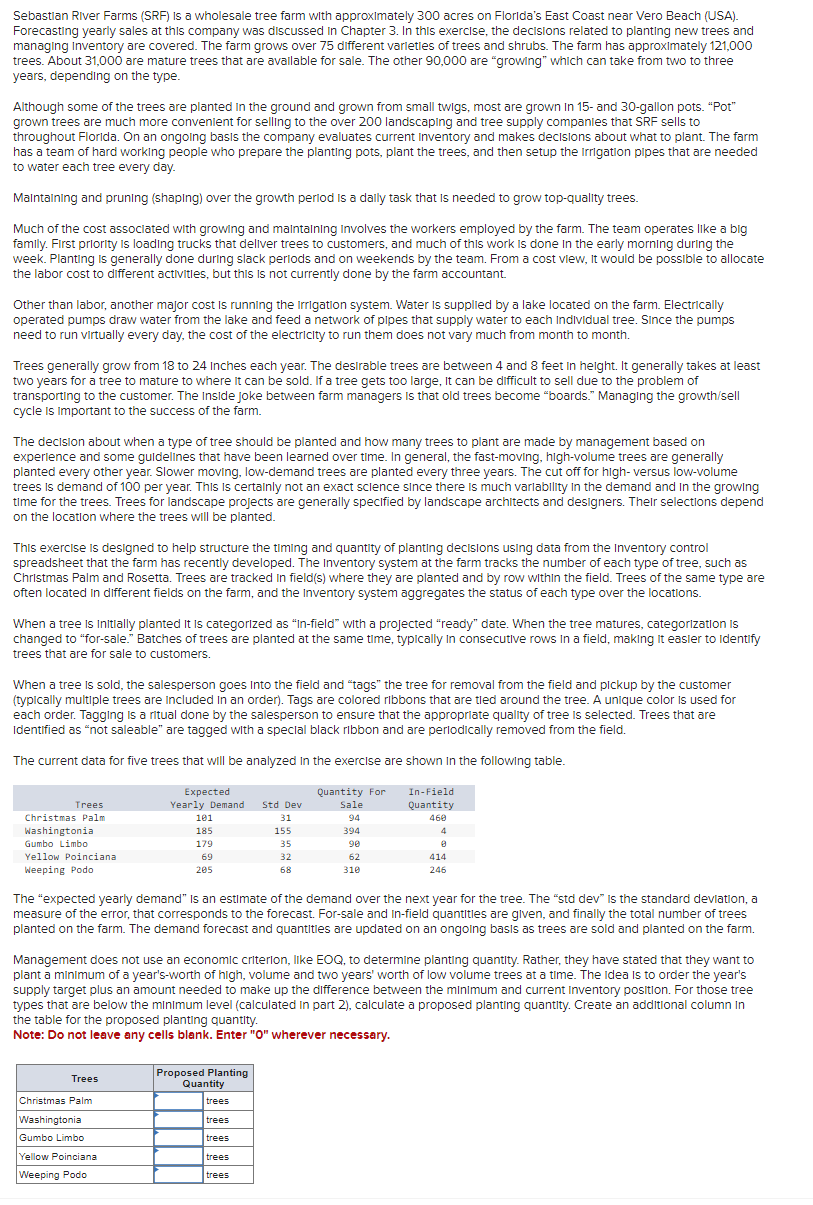
managing Inventory are covered. The farm grows over 75 dlfferent varletles of trees and shrubs. The farm has approximately 121,000 trees. About 31,000 are mature trees that are avallable for sale. The other 90,000 are "growing" which can take from two to three years, depending on the type. Although some of the trees are planted in the ground and grown from small twigs, most are grown In 15- and 30-gallon pots. "Pot" grown trees are much more convenlent for selling to the over 200 landscaping and tree supply companles that SRF sells to throughout Florlda. On an ongoing basis the company evaluates current Inventory and makes decislons about what to plant. The farm has a team of hard working people who prepare the planting pots, plant the trees, and then setup the Irrigation pipes that are needed to water each tree every day. Maintaining and pruning (shaping) over the growth period is a dally task that is needed to grow top-quality trees. Much of the cost assoclated with growing and maintaining Involves the workers employed by the farm. The team operates like a big family. First priority is loading trucks that dellver trees to customers, and much of this work is done in the early morning during the week. Planting is generally done during slack perlods and on weekends by the team. From a cost vlew, it would be possible to allocate the labor cost to dlfferent activities, but this is not currently done by the farm accountant. Other than labor, another major cost is running the Irrigation system. Water is supplied by a lake located on the farm. Electrically operated pumps draw water from the lake and feed a network of plpes that supply water to each Individual tree. Since the pumps need to run virtually every day, the cost of the electricity to run them does not vary much from month to month. Trees generally grow from 18 to 24 Inches each year. The desirable trees are between 4 and 8 feet in helght. It generally takes at least two years for a tree to mature to where it can be sold. If a tree gets too large, It can be difficult to sell due to the problem of transporting to the customer. The Inside joke between farm managers is that old trees become "boards." Managing the growth/sell cycle is important to the success of the farm. The decision about when a type of tree should be planted and how many trees to plant are made by management based on experlence and some guidelines that have been learned over time. In general, the fast-moving, high-volume trees are generally planted every other year. Slower moving, low-demand trees are planted every three years. The cut off for high-versus low-volume trees is demand of 100 per year. This is certainly not an exact sclence since there is much varlability in the demand and In the growing time for the trees. Trees for landscape projects are generally specified by landscape architects and designers. Thelr selections depend on the location where the trees will be planted. This exercise is designed to help structure the timing and quantity of planting decisions using data from the Inventory control spreadsheet that the farm has recently developed. The Inventory system at the farm tracks the number of each type of tree, such as Christmas Palm and Rosetta. Trees are tracked in field(s) where they are planted and by row within the field. Trees of the same type are often located in dlifferent fields on the farm, and the Inventory system aggregates the status of each type over the locations. When a tree is Initially planted it is categorized as "In-field" with a projected "ready" date. When the tree matures, categorization is changed to "for-sale." Batches of trees are planted at the same time, typically in consecutive rows in a field, making it easier to Identify trees that are for sale to customers. When a tree is sold, the salesperson goes Into the field and "tags" the tree for removal from the field and pickup by the customer (typically multiple trees are included in an order). Tags are colored ribbons that are tled around the tree. A unique color is used for each order. Tagging is a ritual done by the salesperson to ensure that the approprlate quality of tree is selected. Trees that are Identified as "not saleable" are tagged with a speclal black ribbon and are perlodically removed from the field. The current data for five trees that will be analyzed in the exercise are shown in the following table. The "expected yearly demand" is an estimate of the demand over the next year for the tree. The "std dev" is the standard devlation, a measure of the error, that corresponds to the forecast. For-sale and in-field quantitles are given, and finally the total number of trees planted on the farm. The demand forecast and quantitles are updated on an ongoing basis as trees are sold and planted on the farm. Management does not use an economic criterion, Ilike EOQ, to determine planting quantity. Rather, they have stated that they want to plant a minimum of a year's-worth of high, volume and two years' worth of low volume trees at a time. The idea is to order the year's supply target plus an amount needed to make up the difference between the minimum and current Inventory position. For those tree types that are below the minimum level (calculated in part 2), calculate a proposed planting quantity. Create an addltional column In the table for the proposed planting quantity. Note: Do not leave any cells blank. Enter "0" wherever necessary







